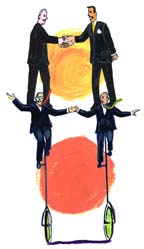U.S. President Clinton’s recent trip to India and Pakistan brought to light the story of how poor rural towns in Bangladesh are communicating with outsiders through cellular telephones, often one per village. Few can argue with the concept that cell phones are connecting the world. In a paper titled “Strategic Participation in Industry-wide Technical Organizations? Relating Informal Interfirm Networks and Alliance Formation,” Wharton management professor
Rosenkopf’s work explores the strategic implications of interfirm networks. While much of the research that has been done in this area focuses on alliances between companies as the ties that form interfirm networks, Rosenkopf’s theory is just the opposite. She suggests that informal networks – and the interaction between members of different companies within these networks – lead to the formation of more sophisticated alliances. That reality, she concludes, has important implications for how companies should approach their involvement in informal networks.
When speaking of informal networks, Rosenkopf refers specifically to the working groups, task forces and technical committees formed by groups like trade associations. These are known as cooperative technical organizations, or CTOs. Interactions within CTOs facilitate knowledge-sharing between employees – often engineers – from different companies. That creates the informal knowledge network so critical, Rosenkopf suggests, to the formation of more formal inter-firm relationships.
“The idea here is that engineers, the ones trained to create the best technology, go to these meetings,” Rosenkopf explains. “Part of that training induces them to try and discuss issues about technology with all these players, even though they’re from competitors. Through the process of discussion and informal know-how training that tends to go on, these engineers can identify opportunities for their firms to share their capabilities or their strong suits in order to develop new technologies and new approaches.”
Rosenkopf calls this a “bottom-up” process of alliance formation, rather than the more common “top-down.” Engineers come back from these CTO meetings, she says, with a new set of ideas that then “bubble up” to the top managers who will be forming the alliances. This “bottom-up” method of forming alliances may have a higher likelihood of success because people at lower levels of the company, often the ones who better understand the various technological intricacies, are buying into the new relationship with another firm from the start.
Rosenkopf found the cellular industry, including companies such as AT&T, Lucent Technologies and Nokia, to be ripe for illustrating her theories on alliance formation. For one, the industry has numerous standards bodies and trade organizations to coordinate its technical progress in the international arena. The Telecommunications Industry Association in Arlington, Va., was a particularly strong source of information that allowed for systematic data collection and analysis. Finding such valuable information had been a problem in earlier work Rosenkopf had done on the flight-simulation industry.
In addition to its focus on standards, the wireless arena was also a good subject because of some inherent traits. “In general, telecom is what we call a systemic technology,” Rosenkopf explains. “Different pieces have to be put together in order to create the overall system that people can use. To develop systemic technologies, you need to coordinate lots of different players. It’s virtually impossible for one firm to do everything, so the concept of cooperating becomes all the more important.”
And finally, the cellular industry was experiencing explosive growth and what Rosenkopf calls “turbulence,” due in part to the emergence of the CDMA standard, a sophisticated digital alternative to existing methods of wireless transmission. Turbulence and uncertainty, she says, force companies to cooperate and collaborate with lots of different players.
In looking at CTO participation data obtained from the Communications Standards Review, and alliance data from Securities Data Corp., a source of all joint ventures and strategic alliances worldwide from 1988 to the present, Rosenkopf was able to identify some interesting patterns. Her analysis is based on 87 cellular firms where financial data was available for at least one of the years 1991-1995. Rosenkopf determined that the number of firms forming alliances in each of the five years varied between 31 and 45.
Over the full five-year period, 60 of the firms formed at least one alliance, while 27 did not form any alliances. Of the 87 firms, 67 participated in at least one CTO over the study period, while 20 never participated at all. The number of CTO meetings grew consistently over the study period, from 16 in 1991 to 47 in 1995, and the average number of meetings attended by firms during the time grew correspondingly, from 5.95 in 1991 to 13.7 in 1995. The result: Firms that interact more seem to form more alliances.
Recognizing the value of community networks like CTOs to knowledge exchange and, possibly, more formal interfirm relationships is merely the first step, Rosenkopf suggests. “If any of this theory I’m laying out here is true, then managers should be thinking about this activity a little differently,” she says. “They may want to look more carefully at their overall patterns of participation and be thinking more strategically about areas they want to get into or players they would like to collaborate with more. There is a lot of room for firms to think about how they are represented in these networks.”



